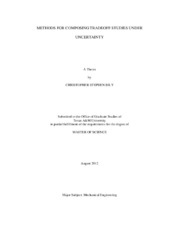| dc.description.abstract | Tradeoff studies are a common part of engineering practice. Designers conduct tradeoff studies in order to improve their understanding of how various design considerations relate to one another. Generally a tradeoff study involves a systematic multi-criteria evaluation of various alternatives for a particular system or subsystem. After evaluating these alternatives, designers eliminate those that perform poorly under the given criteria and explore more carefully those that remain.
The capability to compose preexisting tradeoff studies is advantageous to the designers of engineered systems, such as aircraft, military equipment, and automobiles. Such systems are comprised of many subsystems for which prior tradeoff studies may exist. System designers conceivably could explore system-level tradeoffs more quickly by leveraging this knowledge. For example, automotive systems engineers could combine tradeoff studies from the engine and transmission subsystems quickly to produce a comprehensive tradeoff study for the power train. This level of knowledge reuse is in keeping with good systems engineering practice. However, existing procedures for generating tradeoff studies under uncertainty involve assumptions that preclude engineers from composing them in a mathematically rigorous way. In uncertain problems, designers can eliminate inferior alternatives using stochastic dominance, which compares the probability distributions defined in the design criteria space. Although this is well-founded mathematically, the procedure can be computationally expensive because it typically entails a sampling-based uncertainty propagation method for each alternative being considered.
This thesis describes two novel extensions that permit engineers to compose preexisting subsystem-level tradeoff studies under uncertainty into mathematically valid system-level tradeoff studies and efficiently eliminate inferior alternatives through intelligent sampling. The approaches are based on three key ideas: the use of stochastic dominance methods to enable the tradeoff evaluation when the design criteria are uncertain, the use of parameterized efficient sets to enable reuse and composition of subsystem-level tradeoff studies, and the use of statistical tests in dominance testing to reduce the number of behavioral model evaluations. The approaches are demonstrated in the context of a tradeoff study for a motor vehicle. | en |


